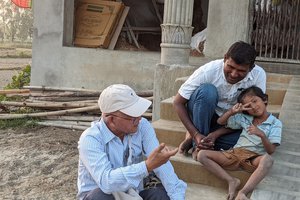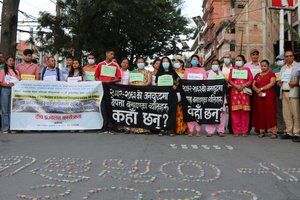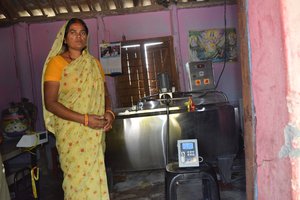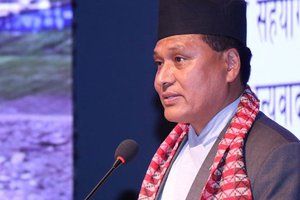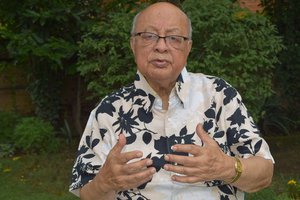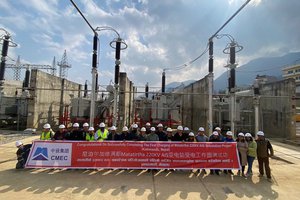Keshab Poudel
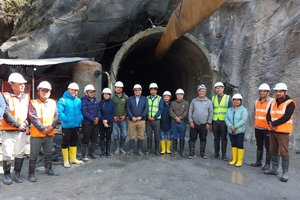
LOSS AND DAMAGE: Upper Tamakoshi A Case
Over the past two years, the 456 MW Upper Tamakoshi Hydropower has witnessed a decline in its generation capacity. This decline is a stark contrast to its initial generation three years ago. The primary reason behind this decline is the reduced water discharge in the Tamakoshi River, which can be attributed to a prolonged winter drought and decreased rainfall and snowfall. The Upper Tamakoshi project serves as a compelling example to highlight Nepal's advocacy for the loss and damage agenda in UNFCCC.
By Keshab Poudel Apr 02, 2024
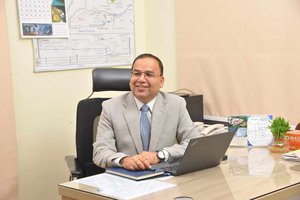
UTKHPL’s Generation Has Significantly Impacted By Changing Weather Pattern: CEO Gautam
Having extensive experience in the hydropower sector, MOHAN PRASAD GAUTAM, the Chief Executive Officer of Upper Tamakoshi Hydropower Limited (UTKHPL), is a well-established manager. With the gradual impact of Climate Change on Nepal's rainfall patterns, the country's hydropower generation capacity is taking a hit in dry session. Over the past three years, UTKHPL generation capacity has significantly declined in the span of three months. CEO Gautam discussed various future issues with KESHAB POUDEL. Here are the excerpts.
By Keshab Poudel Mar 23, 2024
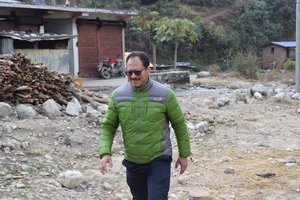
HELVETAS-NEPAL Dr. Prabin Manandhar’s Leadership
Helvetas-Nepal has been actively involved in numerous projects across the Karnali, Madhesh, and Koshi provinces. The organization has increased its responsibilities following the last year’s earthquake in Jajakot. Dr. Prabin Manandhar is the Country Director of Helvetas Nepal. He has extensive experience leading successful relief, rehabilitation, and reconstruction projects in post-disaster areas. He has mobilized the entire team to work closely with provincial and local governments, as well as NGOs. Recently, Dr. Manandhar visited the earthquake-affected regions of Jajarkot and Rukum districts to assess the situation. During his visit, he met with local government officials, provincial leaders, NGOs, and his team to discuss areas where Helvetas Nepal can provide support in post-recovery and reconstruction efforts. Dr. Manandhar’s focus now is to reconstruct the resilient Jajarkot.
By Keshab Poudel Mar 13, 2024
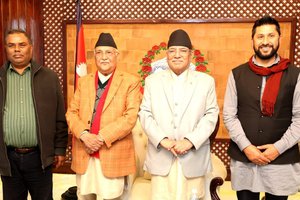
POLITICS: Left, Right, Left Right
Nepal has had three governments in just 16 months, although Prime Minister Pushpa Kamal Dahal Prachanda remains in power. In his recent reshuffle, PM Prachanda appointed 21 ministers from four political parties, including CPN-UML, Rastriya Swatantra Party, Janta Samajbadi Party, and CPN-US, while removing Nepali Congress. As no political party has a majority, it is likely that there will be more coalitions in the future. Maoist leader Prachanda believes that the Nepali Congress leaders' non-committal attitude towards the Maoist-Center is a key factor behind the current political developments, including the changing coalition. However, Nepal's politics over the past five decades has shown a fading ideology. There is no clear divide between left and right when it comes to sharing power, which remains a factor of instability, besides the geo-strategic position.
By Keshab Poudel Mar 12, 2024
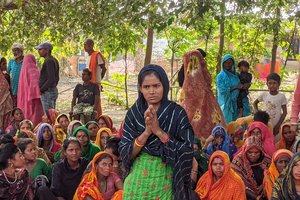
IWD 2024: Helvetas Nepal's InElam Project Transforms Daliit Women
Many Dalit and backward women, such as Shiva Sati Sada, who previously lived in a subsistence-based society, have become entrepreneurs thanks to Helvetas Nepal's InElam Project. They now run small businesses and create jobs in their own locality. The Helvetas Nepal's InElam Project has helped them transition from housewives to business owners
By Keshab Poudel Mar 08, 2024
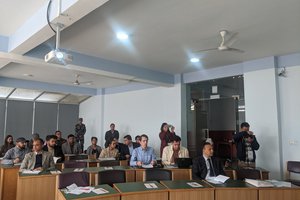
Environmental Peacebuilding In Nepal: Challenges and Opportunities
The number of environmental conflicts in Nepal is increasing, whether it is over wildlife and human conflict for the forest or the usage of water between higher and lower riparian communities. Climate change is likely to exacerbate the conflict. In this context, scholars, practitioners, and academicians discussed numerous concerns in a recent symposium on obstacles and potential for environmental peacebuilding in Nepal.
By Keshab Poudel Mar 05, 2024
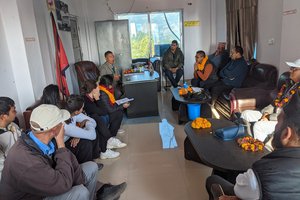
PROYEL: Lesson From Bheri Municipality
Following the implementation of the Promotion of Youth Engagement in Local Governance Process (PROYEL) project, funded by the European Union and Helvetas-Nepal, the youth of Bheri Municipality in Jajarkot District are developing the necessary skills to participate in the local governance process.
By Keshab Poudel Mar 04, 2024

Nepal Has The Potential To Become A leader In Attracting Climate Investment: Scobie Mackay
SCOBIE MACKAY, Chief Executive Officer (CEO) of IMPERATIVE, recently visited Nepal as part of the launch of the Improved Cooking Stove Project. During his visit to Nepal as part of the launch of the Project, CEO Scobie Mackay spoke to KESHAB POUDEL about various issues related to the voluntary carbon market and the possibility of attracting foreign investment in Nepal. Excerpts:
By Keshab Poudel Mar 03, 2024
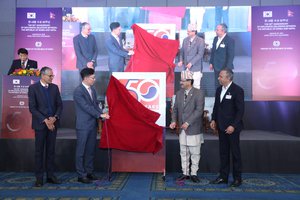
NEPAL-KOREA 50 YEARS: Everesting Friendship
The Republic of Korea (RoK) has made significant progress in the last fifty years since the establishment of diplomatic relations. Nepal has also benefited from Korean economic prosperity. Korean companies have invested heavily in Nepal, and they have provided employment to a large number of unskilled Nepali workers through the EPS program. Korea is now the fourth-largest foreign investor in Nepal. Nepal and Korea, although geographically distant, share many historical and cultural similarities. Every year, 30,000 Koreans visit Nepal for trekking in the Himalayas and pilgrimage to Lumbini, the birthplace of Buddha. Additionally, many young Nepalese people are learning Taekwondo and enjoying K-Pop. Nepal-Korea relations are deepening further.
By Keshab Poudel Feb 15, 2024

Helvetas Nepal's InElam: Banana Revolution!
Helvetas Nepal’s InElam Project has successfully positioned itself as a model for converting subsistence-based agriculture into a profitable enterprise through banana cultivation. This achievement has been made possible through close collaboration with the local government, provincial governments, the private sector, and the youth. By providing assistance to young individuals in the field of banana production, the InElam project has effectively transformed Sudur Paschim, Lumbini and Karnali Province into thriving banana hubs. As a result, young farmers have transitioned from substance farming to cultivating a lucrative cash crop.
By Keshab Poudel Feb 13, 2024
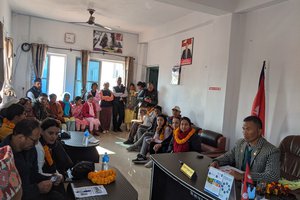
PROYEL: Youth In The Jajarkot Earthquake
Funded by the European Union and led by Helvetas-Nepal in a consortium with two local NGOs, Promotion of Youth Empowerment in Local Governance Process (PROYEL) supported Bheri Municipality. The Youth Panel (YP) members of Bheri Municipality, formed by PROYEL, demonstrated the importance of youth involvement in effectively carrying out rescue and relief operations in disaster.
By Keshab Poudel Feb 02, 2024

TANAHU HYDROPOWER Following Right Track
In order to reach its goal of having no emissions by 2045, Nepal is working toward energy self-sufficiency. It is noteworthy that the Asian Development Bank is supporting the 144 MW Tanahu Hydropower project, which is the second storage-type project after Kulekhani. Despite being nearly two years behind schedule due to setbacks including contractor termination, COVID-19, and new contractor selection, the Tanahu Hydropower Project (THP) is moving forward. The project is expected to start generating by 2027 at the present rate of progress; the river was redirected in September 2023. The project will guarantee a consistent supply of electricity and is located near to the load center. A one-year extension has been requested by the civil work contractor.
By Keshab Poudel Jan 29, 2024
Latest Updates
- Winter Session Of Parliament Ends
- 2 days ago
- PM Oli Arrives In Bangkok
- 2 days ago
- RPP Leaders Mishra and Rana allowed to be detained for 5 days
- 3 days, 23 hours ago
- Nepal Sichuan Trade Exchange Month begins
- 4 days, 11 hours ago
- KMC Imposes Rs 793,000 Fine On Former King Shah
- 4 days, 12 hours ago
- AEPC Helds A National Symposium On Carbon Finance Investment Opportunities in Energy Projects
- 5 days, 12 hours ago
- Police Fired Tear Gas To Control Pro-Monarchst Movemnet In Tinkune
- 6 days, 5 hours ago
- ANNFSU Revolutionaries hold torch procession to protest Kulman Ghising's dismissal
- 1 week ago
- PM Oli, Deuba And Prachanda Discuss transitional justice
- 1 week, 2 days ago
- Kulman Ghising Sacked By Government
- 1 week, 2 days ago
